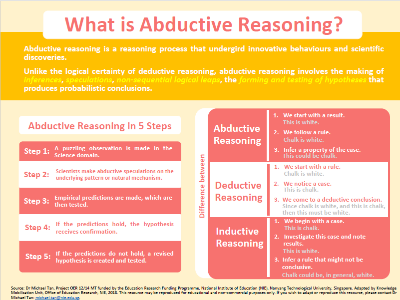Makerspaces
Makerspaces as a Learning Context for Innovative Behaviour
- Makerspaces provide a learning space for:
- creative exploration of problem spaces
- developing their adaptive expertise
- disciplinary practices of scientists, engineers, designers, and a wide range of professions
- inventing solutions to ill-structured problems that challenge students
 Why Makerspaces?
Why Makerspaces?
Makerspaces are in vogue, receiving much attention from schools in Singapore and around the world. A recent instructional trend, educators are curious and interested to either create tangible makerspaces within their school compound or integrate the elements of makerspaces into their curricula.
How Was the Research Carried Out?
- The research team focused on participants’ production of new scientific knowledge through the use of simple electrical operations or complicated micro-controlled based designs. The 8 participant pairs (i.e., 5 student pairs & 3 adults pairs) were asked to design and make a prototype artefact of a device ~ a device that could signal to a teacher that the pair needed attention.
- Given a set of electronic components, some construction material, adhesive tape, hot glue, and a knife, participants’ actions and talk was video and audio recorded for analysis.
 Abductive Reasoning and Makerspaces
Abductive Reasoning and Makerspaces
Innovative behaviours are nurtured in makerspaces as the learning environment provide optimum conditions for abductive reasoning to be practiced.

Image 1: What is Abductive Reasoning? (view larger image)
Potential implementation loopholes
However, before plunging knee-deep into the creation of these makerspaces, it is also important that we consider the purposes, instructional strategies, and learning cultures that shape the makerspace.
It is also important that we are aware of these potential loopholes:
- The “Keychain Syndrome” (Blikstein, 2013)
Blikstein’s “Keychain Syndrome” explains a misuse of makerspaces where students are given low challenge tasks preparing meaningless objects (e.g., keychains) that barely taps on the affordances (i.e., potential) of new technologies.
What this looks like in your learning spaces:
- Do you hand out step-by-step worksheets for students to make objects?
- Are there higher-order and open-ended learning prompts in your projects?
-
Relative to the equipment you have in your makerspace, is the full potential of the equipment played out and integrated into the students’ making experience? (e.g., are the advanced functions of the equipment exposed to students’ exploration and use?)
- Infatuation with Technologies (Cuban, 2001; 2004; Toyama, 2015; Chan, 2014)
We pay greater attention to changing underlying sociocultural processes and epistemic practices before embarking on technology.
What this looks like in your learning spaces:
- Do you have many “white elephants” (i.e., rarely used machineries, equipment) that are in your learning space?
- Do you notice yourself or colleagues keeping up to the latest hype in learning technology, purchasing expensive products only to find that there is little use for it later on?
- Can your equipment purchases be honestly described as solutions looking for problems?
 Evidence from Makerspaces
Evidence from Makerspaces
Two main categories of actions and speech were found, identified as ‘top down’ and ‘bottom up’.
| ‘Top down’ actions and speech | Decide on design goals before trying to find materials and processes to respond to this goal. For example, a ‘top down’ consideration is where participants could decide that the device ought to make use of sounds as an alert medium, and then look for devices that could satisfy this requirement. |
| ‘Bottom up’ actions and speech | A ‘bottom up’ consideration is where participants could be ‘tinkering’—connecting components without appearing to have a design intent. Participants then realise in the process of tinkering that particular configurations could be used for a particular design feature. |
How did the research participants respond?
- The top down design approach provides greatest potential for creative outcomes. This could be done by starting off with a reasoning process “Suppose the design has feature X”, and then attempting to fit materials into this possibility.
- This being said, this approach involves most risk as it is more likely that material configurations cannot be made to confirm to feature X.
- In addition, this form of reasoning requires participants to have a wide-ranging set of interests so as to draw ideas from diverse sources.
- Results suggest that creative problem solvers does best by making as many abductive speculations as possible
 Recommendations for Schools
Recommendations for Schools
- This study provides grounds for recommendations that schools continue to develop students’ interdisciplinary connections on top of strong disciplinary training.
- Knowledge in the philosophical traditions (e.g., arts and humanities) offer us expanded realms of possibilities in which we can potentially direct reality towards
- Innovative behaviours (e.g., making abductive suppositions) involves risks, not in the harm-to-body sense, but in the possibility-for-failure sense. Hence, classroom cultural environments need to remain supportive spaces that defer judgement of competence and reward failed attempts.
 Related Links
Related Links
- Ng, K. (2016, April 24). ‘Makerspaces’ allow students to get messy – and creative. Today Online. Retrieved from https://www.todayonline.com/singapore/makerspaces-allow-students-get-messy-and-creative
 Further Readings
Further Readings
-
Tan, M. (2018). Why STEM? Why now? Educating for technologies, or technologies for education? Learning: Research and Practice, 4(2), 203–209.
 Research Projects
Research Projects
 Research Team
Research Team
To learn more about Makerspaces, please contact the Principal Investigator Dr Michael Tan at michael.tan@nie.edu.sg.
Principal Investigator
-
Dr Michael TAN, Office of Education Research (OER), NIE
Co-Principal Investigator
- Dr Dragan TRNINIC, ETH Zurich, Switzerland (formerly of NIE)
 Acknowledgments
Acknowledgments
This study was funded by Singapore Ministry of Education (MOE) under the Education Research Funding Programme (OER 12/14 MT) and administered by National Institute of Education (NIE), Nanyang Technological University, Singapore. Any opinions, findings, and conclusions or recommendations expressed in this material are those of the author(s) and do not necessarily reflect the views of the Singapore MOE and NIE.
This knowledge resource was written by Ms Tan Giam Hwee in June 2019, updated by Ms Monica Lim on 4 January 2022.







